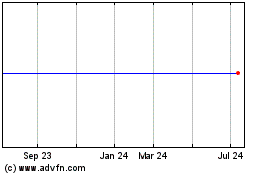By Jesse Newman and Heather Haddon
Supermarkets are starting to look a lot more like take-out
restaurants, but the explosion of prepared meals has brought new
food-safety issues that even leading chains are racing to
manage.
Whole Foods Market Inc., a trailblazer in the sale of
fresh-cooked items, was recently forced to temporarily shutter one
of its commercial kitchens producing fresh meals for stores. The
move was a response to the U.S. Food and Drug Administration's
warning over safety gaps in the Boston-area plant.
The grocer is now overhauling its approach, including
discontinuing the processing of meat, poultry and raw seafood in
that kitchen and two others, according to a letter obtained through
a public document request and the company.
The FDA's warning followed an E.coli outbreak last year that was
linked to rotisserie chicken salad made at Costco Wholesale Corp.
and sickened 19 people. Deli foods from the Boise Co-Op, a
natural-foods grocer in Idaho, were also tied to a salmonella
outbreak last year that sickened nearly 300 people.
The grocers' woes highlight challenges facing supermarkets
competing for consumers forgoing home-cooking and traditional
restaurant meals in favor of fresh offerings from sushi counters or
taco bars at neighborhood grocery stores. As prepared-food
offerings increase in volume and complexity, the risk of
food-safety issues also grows, with supermarkets now facing safety
concerns that have beset the restaurant industry for years.
Fresh prepared foods generated $15 billion in sales in
supermarkets in 2005, a figure that has nearly doubled to about $28
billion last year, according to Technomic, a food industry research
firm.
But while grocers have long offered fresh options from delis and
salad bars, they now are selling more sophisticated meals, which
require more complex cooking and serving practices.
That chicken destined for a chicken biryani dish at the hot
Indian buffet? Employees must cook it to at least 165 degrees for a
minimum of 15 seconds to kill bacteria like salmonella that might
be living on its skin. Rice bound for a cold Mediterranean pilaf
salad must be cooked to 135 degrees, then cooled for two hours to
70 degrees, and chilled for an additional four hours to 41 degrees
to prevent dangerous spores from growing and contaminating
food.
"Our stores have become mini restaurants and pubs," said Paul
Marra, manager of food safety for Wegmans Food Markets Inc., which
now runs full-service restaurants in stores offering everything
from mussels to crème brûlée. "Prior to that, we basically sliced
cold cuts and made a few salads."
Data on foodborne illness outbreaks linked to grocery stores is
delayed and highly dependent on reporting by state health
departments, according to Dr. Sam Crowe, an epidemiologist at the
U.S. Centers for Disease Control and Prevention. But according to
the latest information collected by the federal agency, outbreaks
linked to U.S. supermarkets more than doubled from 2014 to 2015.
That year, 23 outbreaks sickened 572 people and hospitalized 42 of
them.
Salmonella was the most common outbreak tied to stores, followed
by norovirus. Outbreaks stemmed from everything from ribs to
chocolate mousse.
Amber Howard, a 36-year-old Boise resident, said she became
seriously ill from a salmonella infection after eating meals made
at the Co-op last year, and ultimately developed arthritis, among
other ailments. "It's been a horrible year," said Ms. Howard, who
is in settlement talks with the grocer.
The Co-op closed its deli for several days after that outbreak.
It cleaned, retrained employees and color-coded cutting boards to
prevent cross-contamination. A spokeswoman said the company wants
to be "a model" for other co-ops.
While foodborne illness outbreaks tied to restaurants far exceed
those at grocery stores, experts say that gap could narrow as more
supermarkets jump into prepared foods.
Among the biggest concerns stem from employees mishandling
prepared food or not washing their hands while working with it,
said Robert Powitz, a Connecticut health officer and forensic
sanitarian. In New York state, nearly a third of the 15,600
violations at grocery stores in the past year involved prepared
foods, according to an analysis of latest available state
Department of Agriculture statistics. Of those, 221 violations
involved employees' mishandling prepared food or handwashing.
To head off problems, grocers are ramping up employee training.
The International Dairy-Deli-Bakery Association has logged 6,465
completed online food-safety courses taken by grocery workers
through the end of August, up from a total of 2,987 for all of
2015.
But high attrition rates among employees can be a problem at
supermarkets, as is motivating busy employees to adhere to
ever-changing food-safety standards.
For Whole Foods, its trouble started last year after it recalled
batches of its curry chicken and classic deli pasta salads from
East Coast stores after products made in its Massachusetts plant
tested positive for a dangerous form of listeria during a routine
inspection of the facility. FDA inspectors documented around
two-dozen problems with the grocer's food handling over five visits
in February.
The grocer closed its kitchen for two days to conduct a deep
clean, among other steps, according to the letter it wrote to
regulators. A Whole Foods spokeswoman said the company had a
positive meeting with the FDA in August to discuss the measures
taken. The FDA declined to comment.
Eliminating meat handling at its commercial kitchens in Boston,
Atlanta and Maryland will help keep food safe, according to Ken
Meyer, the company's executive vice president of operations. Still,
he said of threats like listeria: "Does it keep me up at night? Of
course."
Write to Jesse Newman at jesse.newman@wsj.com and Heather Haddon
at heather.haddon@wsj.com
(END) Dow Jones Newswires
September 08, 2016 14:24 ET (18:24 GMT)
Copyright (c) 2016 Dow Jones & Company, Inc.
Whole Foods Market, Inc. (NASDAQ:WFM)
Historical Stock Chart
From Aug 2024 to Sep 2024

Whole Foods Market, Inc. (NASDAQ:WFM)
Historical Stock Chart
From Sep 2023 to Sep 2024
